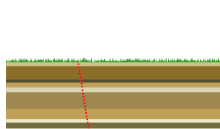Mountain formation:

Movements of tectonic plates create volcanoes along the plate boundaries, which erupt and form mountains. A volcanic arc system is a series of volcanoes that form near a subduction zone where the crust of a sinking oceanic plate melts.[9]
Most volcanoes occur in a band encircling the Pacific Ocean (the Pacific Ring of Fire), and in another that extends from the Mediterranean across Asia to join the Pacific band in the Indonesian Archipelago. The most important types of volcanic mountain are composite cones or stratovolcanoes (Vesuvius, Kilimanjaro andMount Fuji are examples) and shield volcanoes (such as Mauna Loa on Hawaii, a hotspot volcano).[10][11]
A shield volcano has a gently sloping cone due to the low viscosity of the emitted material, primarily basalt. Mauna Loa is the classic example, with a slope of 4°-6°. (The relation between slope and viscosity falls under the topic of angle of repose.[12]) The composite volcano or stratovolcano has a more steeply rising cone (33°-40°),[13] due to the higher viscosity of the emitted material, and eruptions are more violent and less frequent than for shield volcanoes. Besides the examples already mentioned are Mount Shasta, Mount Hood and Mount Rainier.

Mountain formation refers to the geological processes that underlie the formation of mountains. These processes are associated with large-scale movements of the earth's crust (plate tectonics).[1] Mountain formation is related to plate tectonics. Folding, faulting, volcanic activity, igneous intrusion and metamorphism are all parts of the orogenic process of mountain building.[2] The understanding of specific landscape features in terms of the underlying tectonic processes is called tectonic geomorphology, and the study of geologically young or ongoing processes is called neotectonics.
No comments:
Post a Comment